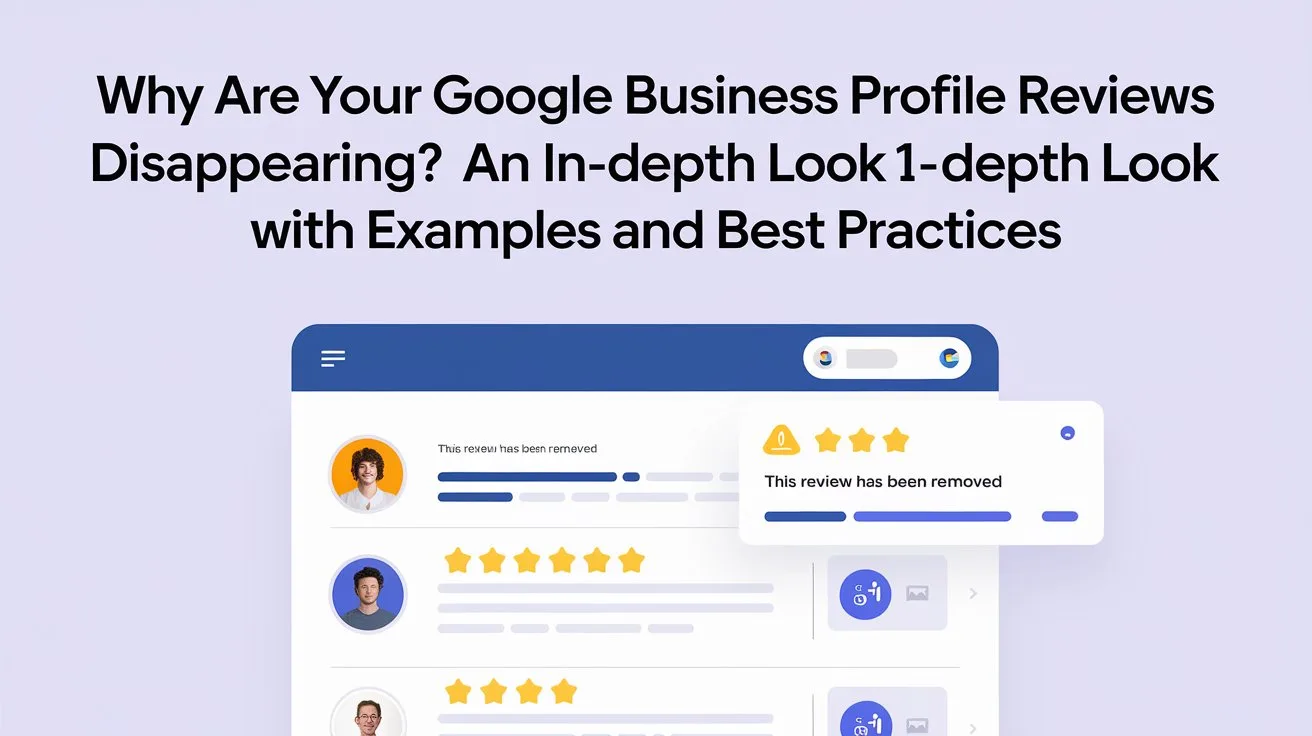Why Are Your Google Business Profile Reviews Disappearing? An In-Depth Look with Examples and Best Practices

Why Are Your Google Business Profile Reviews Disappearing? An In-Depth Look with Examples and Best Practices
If you manage a business using Google Business Profile (GBP), you might have faced the frustration of seeing your reviews vanish unexpectedly. This issue has left many owners puzzled, as Google doesn’t always provide clear reasons for these disappearances. Based on shared experiences, Google’s guidelines, and additional insights, several potential causes can be identified. We’ll explore these with specific examples, explain why it’s so irritating, and offer best practices to help you manage it effectively, while addressing timing, local ranking impacts, monitoring tools, and escalation options.
Possible Reasons for Disappearing Google Business Profile Reviews
1. Policy Violations
Google enforces strict rules to maintain review integrity, and certain content can lead to removals. Here are more nuanced examples:
- Spam or Inappropriate Content: Reviews with links, excessive profanity, or off-topic rants are removed. For instance, a review for a bakery saying, “Best cakes—visit my blog at www.example.com!” might be deleted for including an unrelated link.
- Fake or Manipulated Reviews: Google targets dishonest feedback, like that incentivized improperly or from employees. Imagine a retail store offering a free product for a five-star review—Google might remove these, even if some are from real customers. Similarly, a review from a disgruntled ex-employee saying, “Terrible management after I left!” could be flagged if it’s tied to their employment history.
- Specific Violations: Other examples include reviews with sexually suggestive comments (e.g., “The waitress was hot!”) or detailed personal attacks (e.g., “The owner cheated me out of money!”), Both of which violate Google’s content policies and lead to removal.
2. Google’s Algorithm and Updates
Google’s technology evolves to improve review quality, but this can cause fluctuations:
- Spam Detection: Automated systems flag suspicious reviews, sometimes removing genuine ones by mistake. A small café might lose a real customer review if it’s posted near several flagged ones from the same IP address.
- Algorithm Updates: Updates can tighten filtering, occasionally taking down legitimate feedback. A gym owner noticed a review drop after an update, with some reviews reappearing a week later as Google refined its process. This temporary fluctuation can manage expectations—reviews might disappear and return after adjustments.
- Impact on Local Ranking: A significant review drop might indirectly affect your local search ranking over time, as Google considers review volume and quality. While not immediate, a sudden loss (e.g., 10 reviews) could lower your visibility in local searches, though this depends on other factors like proximity and relevance.
3. User Actions
Reviewers’ decisions can lead to disappearances:
- User Removal: Customers can delete their own reviews. For example, a diner at a restaurant might remove a positive review after a later bad experience, impacting the business’s rating.
- User Deactivation: If a reviewer deactivates their Google account, their review vanishes. A car repair shop lost a glowing review when a customer closed their account for personal reasons.
4. Business Profile Issues
Problems with your GBP setup can affect reviews:
- Suspension and Reinstatement: After a profile is reinstated from suspension (e.g., for duplicate listings), reviews might be removed. A salon lost reviews when its profile was restored after a temporary ban.
- Listing Inactivity or Issues: If your profile is inactive, has outdated details (e.g., an old address), or has multiple listings, reviews can become invisible. A café owner found reviews missing after neglecting updates for months.
5. Contacting Google Support
If you suspect a mistake, you can seek help:
- Request a Manual Review: Contact Google Support to ask for a case review. A florist submitted a ticket with screenshots of a lost review, and Google reviewed it, though not all were restored.
- Provide Evidence: Include proof like screenshots or customer details. A retail store lost 10 reviews and submitted customer emails—Google restored three after investigation.
- Escalation Paths: If initial support doesn’t help, try the Google Business Profile Community forum or escalate via a detailed email to support@google.com, mentioning your case ID. Some users report success by tagging @GoogleMyBiz on Twitter for faster attention, though results vary.
Examples of Reviews That Might Be Removed
- Inappropriate Content: A review saying, “Rude staff, total jerks!” with offensive language might be deleted.
- Spam: A review with, “Great food—click here for deals!” and multiple links could be removed.
- Incentivized Reviews: A review like, “Loved the service, got a freebie for this!” might be flagged if tied to a reward.
- Fake Reviews: A review from a new account with no history, praising a business they never visited, could be taken down.
- Reviews from Employees: A review from a staff member, even positive, might be removed if Google detects the link.
Why Is This So Frustrating for Businesses?
The lack of transparency from Google is the main frustration. Picture a family-owned pizzeria losing five positive reviews overnight with no explanation—was it a glitch, a policy breach, or a customer’s choice? Without clarity, the owner can’t act, and a lower rating might deter new customers. The effort to build those reviews feels wasted, adding to the stress for businesses relying on their online reputation.
Best Practices to Prevent Review Removal and Manage the Issue
To reduce risks and stay prepared, follow these actionable steps:
- Encourage Genuine Reviews:
- Best Practice: Ask customers for honest feedback without rewards. A bookstore owner includes a note with purchases saying, “Share your real thoughts on Google!” This brought in steady, authentic reviews.
- Tip: Train staff to ask politely in person, avoiding incentives like discounts.
- Monitor Reviews Regularly:
- Best Practice: Check your GBP dashboard weekly. A hair salon owner reviews their listing every Sunday and spotted a loss of two reviews, reporting it quickly.
- Tip: Use a log to track review numbers and dates. Consider third-party tools like ReviewTrackers or Grade.us (if budget allows) for multi-platform monitoring, though test their neutrality first.
- Maintain an Active Profile:
- Best Practice: Keep your GBP updated with current hours, address, and photos. A restaurant owner updates their menu weekly, ensuring reviews stay visible.
- Tip: Respond to reviews to show activity, boosting engagement.
- Document Everything:
- Best Practice: Save evidence of reviews. A mechanic collected screenshots of a five-star review that vanished, using them to contact Google successfully.
- Tip: Ask customers for a copy if a review disappears.
- Contact Google Support:
- Best Practice: Report significant losses with evidence. A retail store lost 10 reviews and submitted a detailed request with customer emails—Google restored three.
- Tip: If initial support fails, escalate via the Google Business Profile Community or email support@google.com with your case ID; some find @GoogleMyBiz on Twitter helpful.
- Understand Google’s Policies:
- Best Practice: Learn the guidelines and share them with your team. A café owner posted a sign asking customers to avoid personal attacks, reducing violations.
- Tip: Keep a printed guide handy for quick reference.
Turning Frustration into Strength
The disappearance of Google Business Profile reviews often stems from Google’s efforts to ensure quality through policy enforcement and algorithm updates, which may cause temporary fluctuations. User actions, profile issues, and potential local ranking impacts add complexity. While frustrating, especially for a small bakery losing key feedback—you can take charge. By encouraging honest reviews, monitoring regularly (with or without tools), maintaining an active profile, documenting losses, seeking support (and escalating if needed), and following Google’s rules, you can build a resilient online presence.
Don’t let this discourage you. Start today by checking your GBP, thanking a recent customer, and updating your profile. With these best practices, you can keep your business thriving despite the challenges!
Special Note: Results may vary by case, and Google’s decisions are final. Adjust these practices to suit your business’s unique needs. Third-party tools are optional and should be

Blog Admin:
Ravinder Bharti
CEO & Founder - Public Media Solution
About: Ravinder Bharti is the Founder and CEO of Public Media Solution,
a leading
marketing, PR, and branding company based in India.